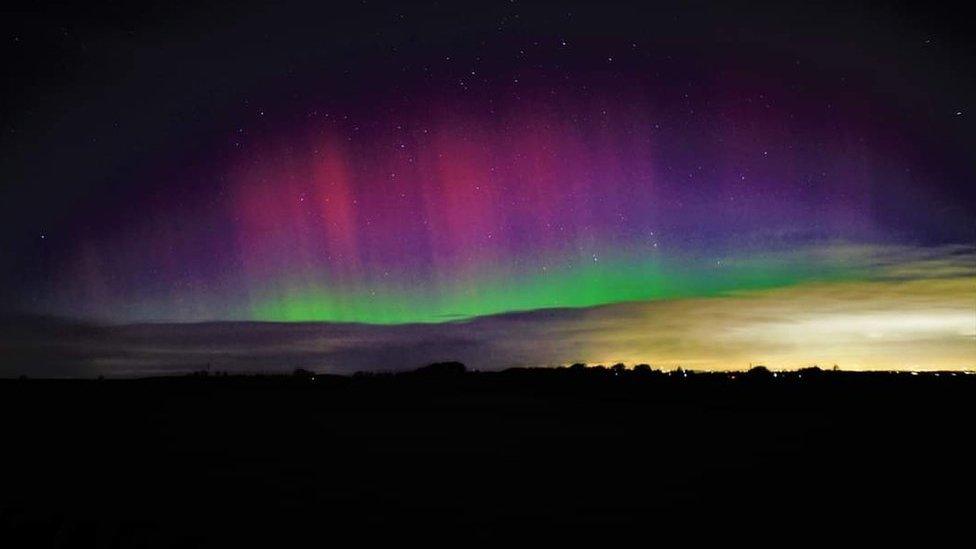Northern Lights award for Welsh photographer Mathew Browne
- Published
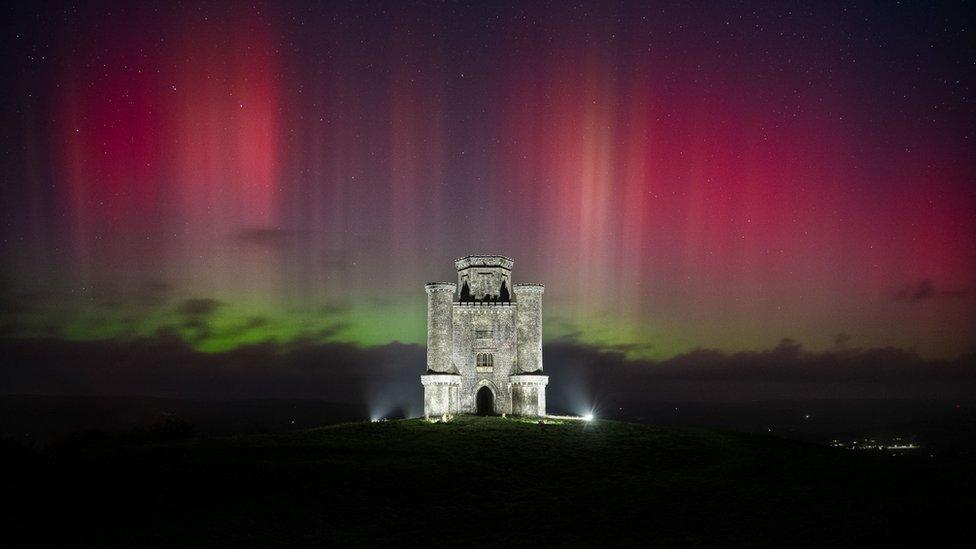
Mathew Browne says it was "bonkers" that he got this photo in his home country
Mathew Browne travelled to Iceland to see the Northern Lights - but it is his picture taken 10 minutes from his west Wales home that has won him an award.
He was so frustrated with his poor shot of the Aurora Borealis in Iceland that he made it his "mission" to improve.
But instead of going back there for the perfect pic, he captured it just up the road in Carmarthenshire.
Now his Paxton's Tower image has been named a winner in the 2023 Northern Lights Photographer of the Year awards.
It is in a collection featuring 25 of the best photos of the Northern Lights taken around the world.
But what does it take to capture such a spectacular picture of the phenomenon?
Mr Browne, from Porthyrhyd, near Carmarthen, first got into photography through his love of travelling.
One thing on his bucket list was to see the Northern Lights, and on a trip to Iceland with his wife Louise, he managed that.
"They were beautiful, but I didn't have a scooby doo what I was doing with my camera," he said.
"I had a rubbish little point-and-click thing, and a rickety hand-me-down tripod, and I was just so disappointed that I saw this amazing thing, and I didn't have a photo of it.
"I then made it my mission to learn how to be a better photographer and one day go back to Iceland to get a picture of the Northern Lights.
"I haven't been back yet, but it's kind of ironic that I managed to get them on home turf," he said.

What is the Aurora Borealis?
The cause of the Aurora Borealis, also known as the Northern Lights, is charged particles from the sun hitting gases in the Earth's atmosphere, in a similar way to how fluorescent light tubes and neon signs work.
They occur around the North Pole when the solar wind carrying the particles interacts with the Earth's magnetic field.
They only occur when a radiation storm or geomagnetic storm occurs in the Earth's atmosphere, and can be seen best at night with a clear sky.
Green is the most common colour, which occurs when the particles hit oxygen in the lower atmosphere. Red appears when the particles hit oxygen in the upper atmosphere, while blue or purple occur when nitrogen is involved.

The 39-year-old has been a full time professional photographer since 2017 and was one of two Welsh winners at the awards.
"Preparation is key to get a photo like this. If you were living in the Arctic Circle you could open your front door and they would be upon you, but that's not going to happen here, you need to be prepared.
"I have a couple of apps that will alert me if there is a chance of seeing them, but that doesn't mean you definitely see them," he said.
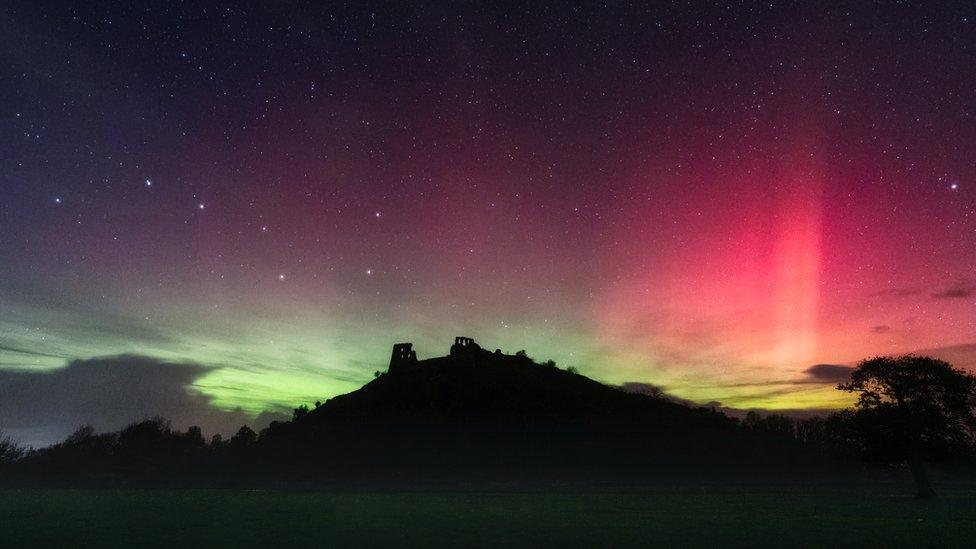
When he took this photo of the Northern Lights over Dryslwyn Castle, Mathew Browne was with friends and family high-fiving at the spectacular sight
His winning photo was taken a 10-minute drive from home.
"I'm not exaggerating when I say I've been up there 100 times trying to get that shot, and I've had a couple of near misses where it's been faint, but time to time you'll get an alert that there is increased geomagnetic activity."
He said there has to be a lot of activity for the Northern Lights to be visible in his part of the world, and it was exceptional to see them this far south.
He had the alert on the night of 25 September "just after Wales had smashed Australia in the World Cup, so I wasn't ready to go to sleep, and I thought I'm just going to go out and see what I can see".
He said: "It was a very diffused pink, and wasn't visible to the naked eye, but it was coming out the back of the camera.
"So I set my camera up and waited to see if something would happen, and it was right place, right time," he added.

Mathew edited the photograph he took of the Northern Lights over Dryslwyn Castle, to look fainter with little to no colour which is his interpretation of how the lights look to the naked eye
At about midnight he could see pillars of light rising from the horizon, and captured the image by taking one under-exposed image, one over-exposed and then one in the middle, to be the balance between the two, a term called bracketing, or HDR mode on the iPhone.
"It was absolutely spectacular, and I was ringing everybody I knew who lived locally to see if they were awake and stick their head out of the window.
"I rang a mate who lives five miles away and his wife wasn't happy that I had woken them, and I said trust me, stick your head out of the window and you'll thank me, and they saw the lights, so I wasn't in the doghouse.
"It only lasted three to five minutes, but the rest of the night, and I mean the whole night you could still see that pink glow," he said.
The experience can be lonely, but also a "magical feeling" and "very special."
Mathew's tips for capturing the Northern Lights
Be patient and do not be disheartened when it does not go your way, which is most of the time
Get some thermals, take a thermos and a deck chair and make a night of it - expect to be there for a couple of hours
Find an unobstructed view facing north, where you get a fairly clear view of the horizon. This could be on a hilltop or on a north-facing beach.
Get the apps on your phone so you can get the alerts
Join specific Facebook groups for the Northern Lights in the UK
Avoid looking at your phone or camera - let your eyes adjust and you will be able to see some gentle pinks and greens happening in the distance
Use a tripod
Use the widest aperture available to you to let the most light in
Have your exposure between five and 20 seconds
Have the sensitivity of your camera really high
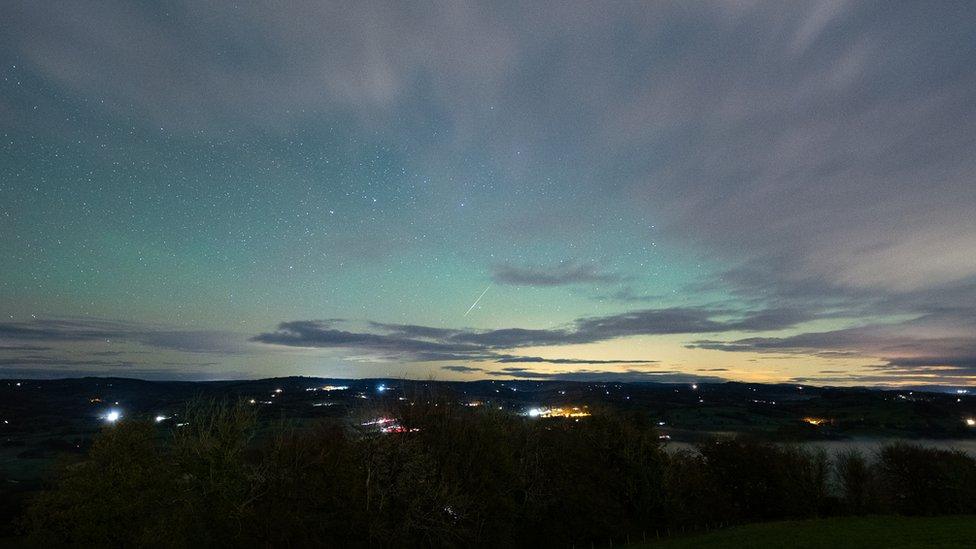
Mathew Browne says he was lucky to capture this picture of a small meteor whilst photographing an early evening aurora
"It's so rare to get a display that is strong and visible from here.
"I've been trying for 10 years to get a photo like this and it is only this year that I have managed to do it in a substantial way.
"Time moves very quickly when I'm out, but if you ask my wife, she would tell you I'm out all night.
"Being the winter the hours aren't as punishing, but I am out for a good three to four hours to see the storm until it dies down."
However, he has encountered suspicion with claims could not see the Northern Lights from Wales, and that his work is photoshopped.
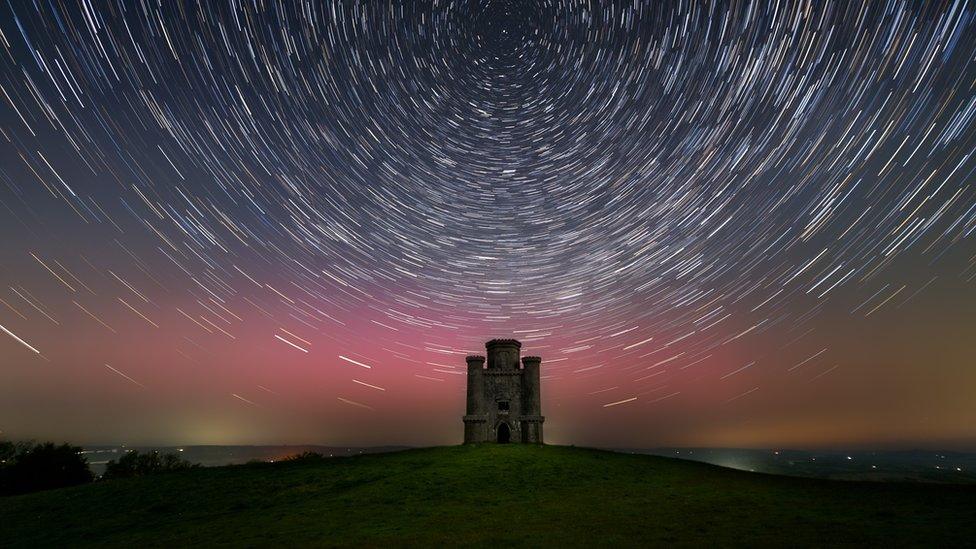
130 images which are digitally stacked to create star trails, revealing the faint pink aurora that could not be seen to the naked eye or in individual frames
"This is because people's expectations aren't correct in terms of what you are going to see with the naked eye.
"I'm sure a lot of people the night I took that picture would have been driving home and didn't even notice it, because it's not as colourful to the naked eye."

WALES' HOME OF THE YEAR: Which home will be crowned the winner?
BAFTA CYMRU WINNERS: Check out these award winning shows

Related topics
- Published2 January
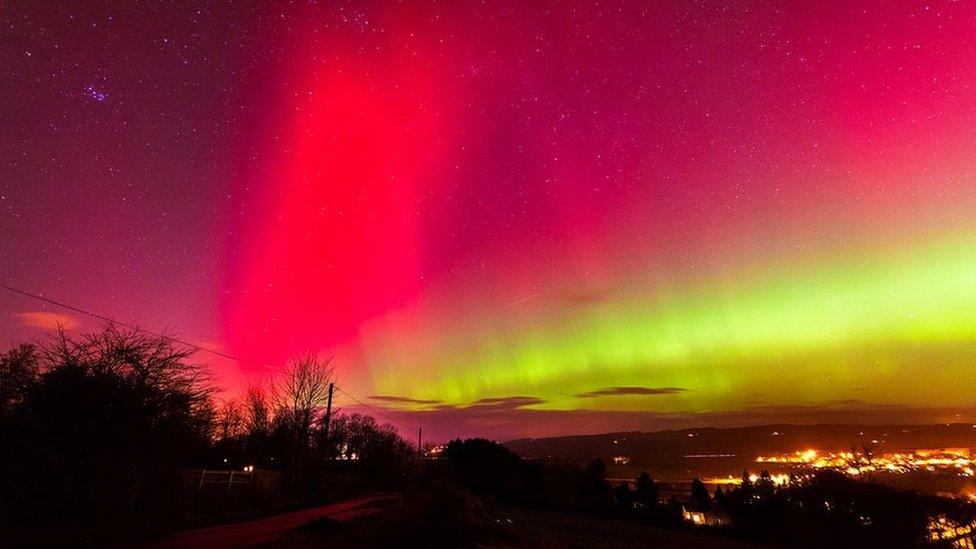
- Published6 November 2023

- Published6 November 2023

- Published25 September 2023
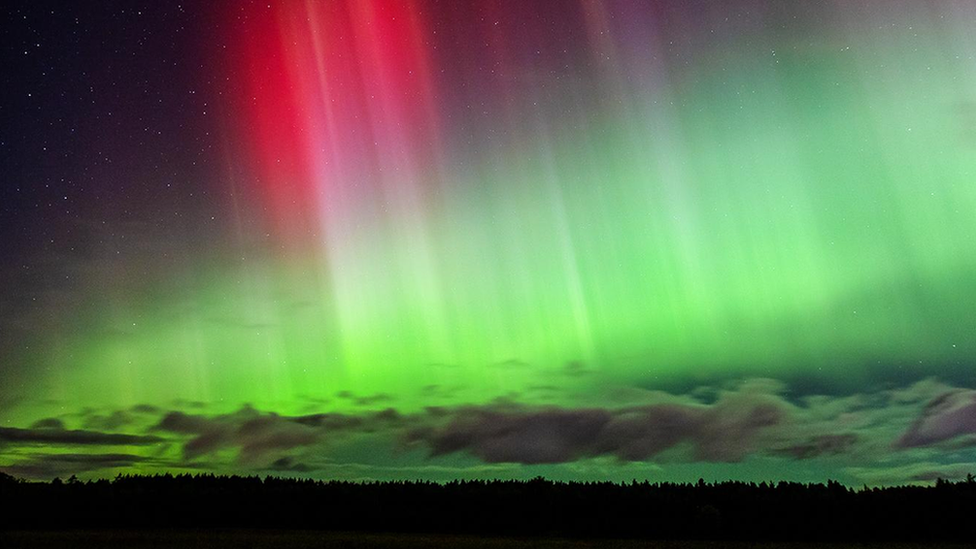
- Attribution
- Published25 September 2023
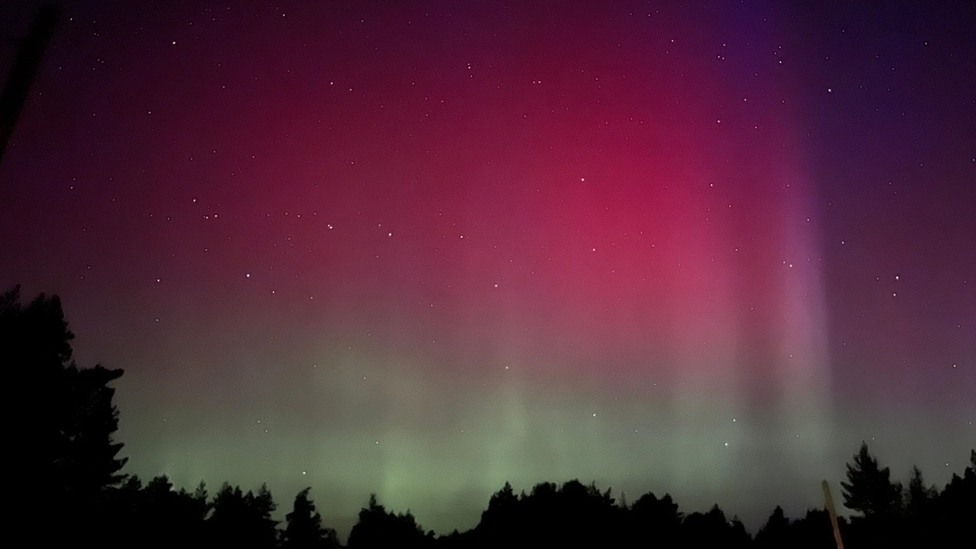
- Published29 April 2023
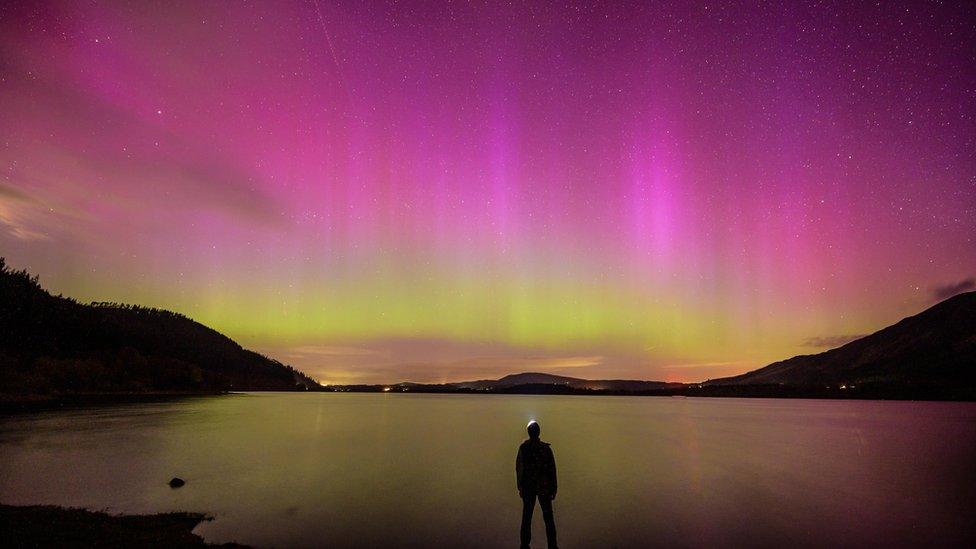
- Published4 March 2023
